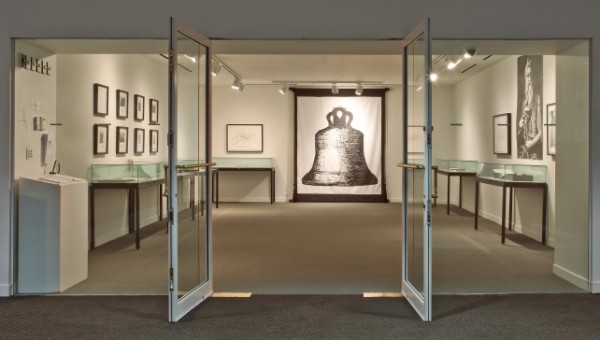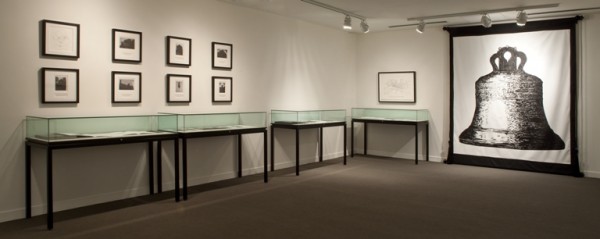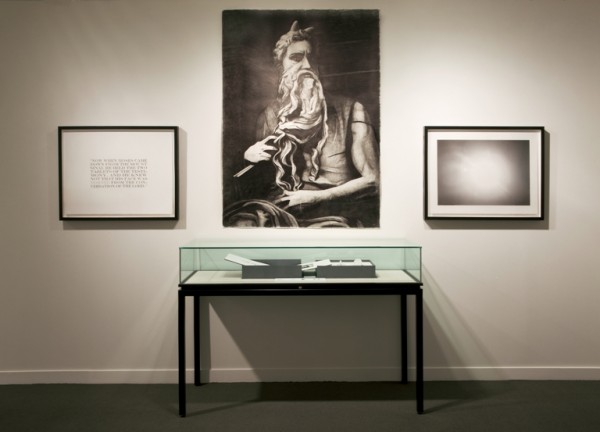If you were to go into the Hawn Gallery in the Hamon Arts Library at SMU right now, you’d think you’d entered an exhibit of some of the University’s collections of old documents — papers pulled out of a file to air out a bit and make us remember something we’d forgotten or teach something we never knew. It’s a very proper-seeming little space: display cases line the walls; everything is black and white; it’s visually and aurally quiet. A big painting of a bell hangs on the far wall; a to-scale drawing of Michelangelo’s Moses hangs on the right wall; there are framed maps and photographs. And though there is information aplenty in the cases and on the walls here, there are not, actually, any real historic documents. Rather, replete with all the decorum and precision that befits the informative setting of the library, you’ll find the research-based artwork of Andrew Douglas Underwood.
Underwood culls from historical vignettes — the past’s leaded little moments full of romantic undercurrents — and translates that information into folios, books and prints that aggrandize and play back history’s minutiae with an exacting factuality. By all appearances, the perfect accordion folios and archival boxes that are the stuff of Underwood’s art (all handmade expertly, stunningly, by the artist himself) seem to be records meant to instructively relay history. They look incredibly serious, undeniably important, resolutely truthful. But there is a streak of sharp wit that pierces the neat trappings of this meticulous work that delights in challenging and thoughtfully surprising ways.
At the heart of it all is Underwood’s deep interest in history, its veracity and the romantic or whimsical sub-layers that can be spun from it, as well as an interest in how we convey and present that information. The folios and accordion books that catalog the artist’s research on particular subjects try to relay each subject’s known facts in as an exacting and clear a manner as possible through a series of detailed paperworks. A book about the history of the bell Great Tom of Westminster, for example, contains the chronology of the bell’s life from its time in Westminster to its transfer to St. Paul’s Cathedral, a bell works diagram, a map of the city of London with the bell’s locations plotted, and other materials. The paperwork creates a beefy, detailed portrait of an inanimate thing, and here in the Hawn Gallery space, Underwood has also installed a to-scale painting of the bell, a literal portrait, outfitted with velvet ropes and tassels. It feels like a theater curtain and backdrop all at once, and it teases notions of the theatrical reverence we give anything that history has made iconic.
Another piece, I.C.U.S.X. & E.R., references the carved inscription found on a window pane in the Essex House in London that purportedly alludes to a house-dweller’s witnessing of an amorous tryst between the Earl of Essex (S.X) and Queen Elizabeth, or Elizabeth Regina, as she was called at the time (E.R.). For this piece, Underwood photographed the locations at the Essex House where this liaison was to have taken place. The photographs are largely of the Essex House grounds — gravel-pathed gardens spiked with conical trees that reference, more than a little, the phallic nature of the Queen’s relationship with the Earl. Across one such picture, Underwood has laid the insignia “E.V.G.R.N.,” which can be read two ways: Evergreen and A Virgin, neither of which, history tells us, was particularly true of old E.R. It’s a wonderful undoing of the seeming purity of both the queen and the pristine way Underwood presents the historical information.
The Horns of Moses is a piece that plays with the use of the word “horned” in the description of Moses coming down from Mount Sinai in the Latin vulgate translation of the Bible: “Now when Moses came down from the Mount Sinai, he held the two tablets of the testimony, and he knew not that his face was horned from the conversation of the Lord.” It was this translation the Michelangelo used as the inspiration for his mammoth work Moses at the tomb of Julius II, which is why that good marble-man (much to my former collegiate confusion) is depicted with horns atop his flowing locks. The original Jewish word for “horned” was the same word as “shone,” with only the context of the sentence to define which word was which. Underwood has rendered a scale likeness of Michelangelo’s Moses here with the “horned” Bible verse on one side of him and a radiant light-burst photograph on the other. In the vitrine in front of the wall components is a book on the subject, as well as a box with two sawed-off, plaster horns. Underwood says that this piece addresses ideas of perfection. The idea that the quintessential artist-perfectionist, Michelangelo, may have gotten it all wrong in “horning” Moses, as it were, is a fascinating one, especially in light of the misuse of the word in a sacred text (and, exponentially, in light of Michelangelo’s own fabled preferences). Underwood undoes the mix-up and symbolically severs Moses’ horns, perfecting the statue by remove, making it right. Of course, nothing is really changed in doing so, except whatever trust we put in language itself.
As a body, Underwood’s leveled and intelligent work acts as a challenge to paradigms we largely take for granted: museums and libraries as receptacles of knowledge, galleries as market places for emotionally-charged goods, classrooms as arenas of learning, historical icons and landmarks as public domain. What happens through his gentle jostling is a shift in experience — a literal twisting of expectations of both the places where we act out life, and of the material we use to guide us through it and enrich it. Underwood’s exquisite, uncompromising archival work attempts to draw out a more thoughtful encounter with the rich fragments of the past that we’d have no need to engage with, were it not for his suggestion that we look again. The connections he makes between the literal, the imaginary, the elevating and the conspiratorial, through all the component parts of each piece and always just beneath the surface of Fact, are masterful and compelling, though humble enough to be quiet in their excellence.
(all photos courtesy Andrew Douglas Underwood)






1 comment
A side note: Michelangelo did not get it wrong by “horning” Moses. By the time of this magnificent statue’s carving, the error in translation was widely known among educated theologians and had been for some time. The choice to include the horns in this work probably owes to the fact that they were a long established iconographical tradition in depictions of the biblical hero. The decision to include them in this rendering may have been made by Michelangelo, but was more likely made by theological advisors within the Catholic Church, perhaps even the Pope himself.